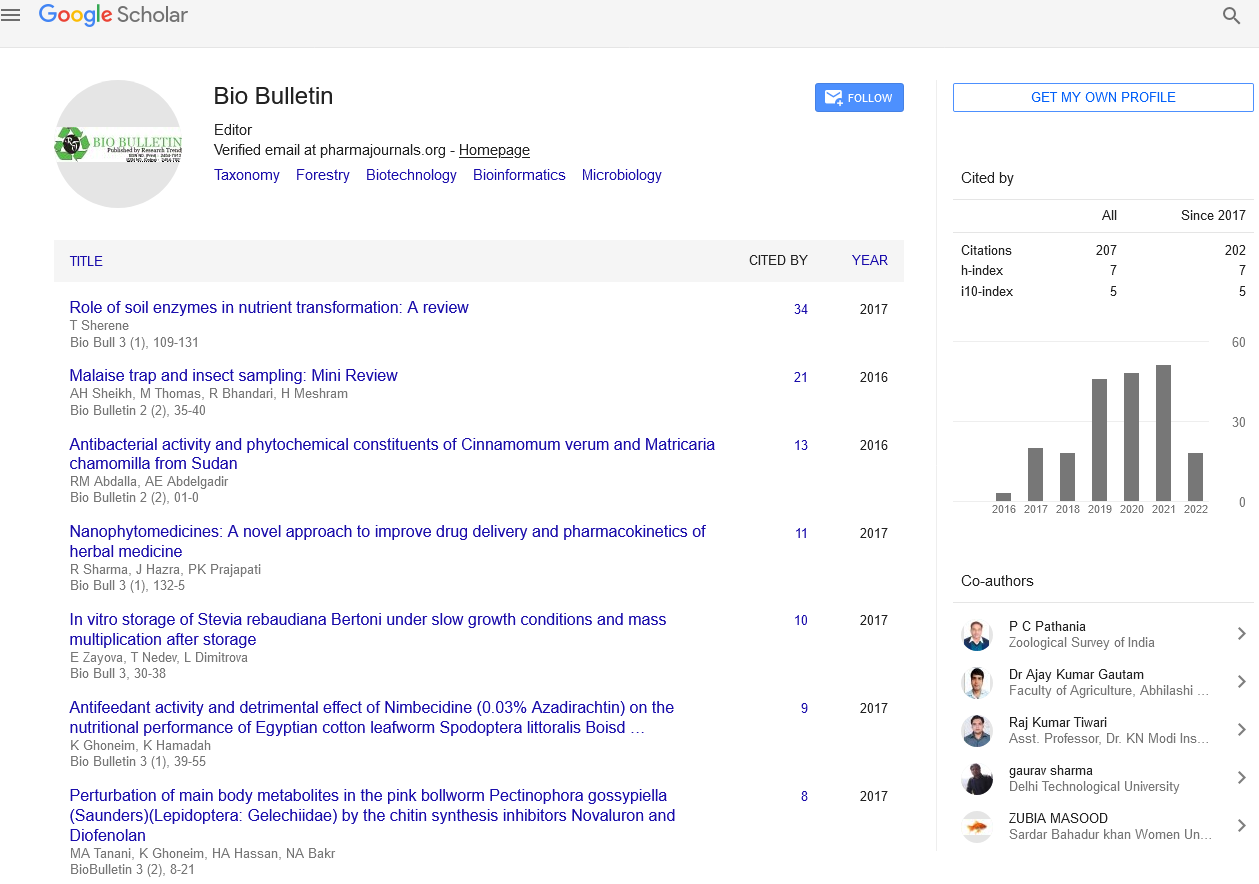Stem Cell Research in Platyhelminth
Commentary - (2021) Volume 7, Issue 2
Commentary
Acoel and platyhelminth worms are particularly attractive invertebrate models for biological research because their bodies are continually renewed from large pools of somatic stem cells. In particular, these studies ultimately led to the discovery that planarians possess a very unusual stem-cell system the body of a planarian is continually rebuilt from a large pool of somatic stem cells, called neoblasts, that are distributed throughout the animal. Neoblasts are the sole mitotically active cells within the body and constantly proliferate to renew all cell types. Neoblasts are thus required for whole-body homeostasis and are likewise liable for forming new tissues by growth and regeneration in these animals. Other platyhelminths also possess an identical stem-cell system, including one among the foremost basal lineages within the phylum, the macrostomids. Thus, it's likely that possession of neoblasts is ancestral for the Platyhelminthes.
Acoels have historically been placed within the Platyhelminthes, but recent molecular phylogenetic analyses now suggest that they probably represent a definite phylum, the Acoela, that falls well outside of the Platyhelminthes. Specifically, acoels are now thought to represent the foremost basal lineage within the Bilateria, being the sister group to all or any other bilaterian animals. That an identical neoblast system is found in both Platyhelminthes and Acoela has important implications for the evolution of this unusual mode of homeostasis. If acoels are indeed the outgroup to all other bilaterians, the neoblast stem-cell system may have evolved convergently in acoels and platyhelminths or, alternatively, may even be ancestral for all bilaterian animals.
Because of their unusual neoblast system, platyhelminths and acoels are particularly attractive invertebrate models for biological research . They present variety of benefits , including the very fact that an outsized pool of stem cells is out there throughout the lifetime of every individual; the stemcell pool is collectively totipotent, not just pluripotent (neoblasts can even produce to the germ line), these stem cells exhibit high rates of turnover, undergoing continual self-renewal and production of differentiated progeny, and neoblasts are the sole proliferative cells within the body while the remainder of the body is post-mitotic, making it possible to selectively disrupt large pools of stem cells in vivo through whole-body irradiation or other techniques.
Because neoblasts are the sole proliferative cells within the body, irradiation that kills proliferating cells selectively destroys neoblasts. Studies administered decades ago showed that in planarians, destroying the neoblast population of adults by whole-body irradiation leads to gradual malformation of the body (as tissues fail to be renewed) and eventually death. Destruction of the neoblast pool in planarians also abrogates the typically extensive regenerative ability of those animals demonstrates that in acoels irradiation dramatically reduces cell proliferation, abolishes the expression of a somatic cell marker, and ultimately results in death, indicating that neoblasts are required for homeostasis in acoels, as they're platyhelminths. The selective destruction of neoblasts by irradiation is a powerful tool in these animals. For example, a key aspect of the microarray study described above was the comparison of irradiated and unirradiated planarian tissue to reveal neoblast specific genes.
Author Info
Pyush Samal1*, Tud Lei2 and Shankar Chillar32Department of Zoology, Govt. Higher Secondary School, Litter (J&K), India
3Department of Environmental Science, Govt. Degree College, Bijbehara (J&K), India
Received: 15-Jun-2021 Accepted: 29-Jun-2021 Published: 06-Jul-2021
Copyright:
sushihouse kolstads americanpridefasteners trueforge hotelposeidon youngswoodfinishing arditomason thebestofreno eeclongisland doktervanhecke famsales adla bogatylaw prefplastics kirbycontractinginc unlsp boban dottoressaromolimonica thebestofsanfrancisco vernix digitaldocuments tristatepropertybrokers sotrafib cemcorpny agenziaimmobiliarebuti joesitalianfoodmarket corpoguardiedicitta icsatc antoniniassicurazioni besel strappedincarseatsafety drevobeton blessingconstructionny centre-endorphine qmbtunisia elearning 357 mpress rrappliance ciaautomazioni antikva stubbanvel tacticalpublicrelations mpulshnk paulyboybrand lordshoes ijd-procom thebestrestaurants atkpalvelut ceat leonfukspc pilotexamssa ashgrovecabins universalshielding thebestofcharlotte johnjmazurinc rollnroaster thecabinetwarehouse pocketchangeduo thebestofmilwaukee resan sooli vwe centralwindowcleaning reinforcedplasticslab bugbustersofli ciandrigiardini arfada centrumeigenwijs thebestofmemphis maisonpearly islipll dcgraphicsinc agetranquille relisandroth thebestofcharleston traiteur-wn safi-ingenierie justmyvoice harrishardware louisbarbatolandscaping brightstartoursworld rga-insurance calacatajumper ezantia mrcheapocds van4holiday cigap richtour fagyhatar sicc weshopmall ventovuori sobatrapcapbon unityrubberllc thebestofsaltlakecity ircinc sescoindustries connply storen-servicesenter psnry greatneckcollision ironfitendurance tuscanycountryhouse sansovinocalcio bbradydesign samsam vdtarification springersoil thebestofdayton milantechnology labradoodlesoflongisland daliamohamed theconsultantpowerhouse gunnbrush kruunuosk shulmanproduce balcosupply conso-med federalnetworks bellmoreglass alwaysaffordableconcrete jayteeinsurance carolina-cabins cmorfinance stretchritepackaging dishaairwaysenterprise biocontrol distribio peterivill lcc inspekta jvidesigns royalroseinc calabriapizza fadhila prato-pronto-effetto arbemachine olsonelectricnj tkbl tuttifotokft alpernmd ggsupplywholesale almaxcorporation sotuflex ecustomgutter studenipotok metal-lineconcept rettsodontologi nutecsystems aclotbeach gjonnes-bygg cavalierinternational mnemos southfloridashuttles ajchemicalsupply rachelsfireisland concepto nesponge ultimatestylesofamerica techniquesmadeeasydrivingschool stevesmeatsfreeport eastwest gritbrush plussplan biosens viltkam wikaya paintballconcept justmyvoice securecarkeysupply justmyvoice allcountylegal catt plugandcharge ttandlcontracting justmyvoice islandboatlettering gms-tunisie sportsiena bloeiop touchofclasscollision kotekservice ittoscana pallongislandlacrosse industrialfinishings painoutband rakvag-batforening konemies rrfamilychiropractic infienile shbcgroup footpharmacydirect scuolaguidaprato ans-nettoyage autoskola saafa autolaky1 fixcars longislandelitelandscaping rayscan palaconstruction studio44 crealhome viniferi gavinburke ciprianigiardini davidpokorny osteriailcapodaglio thebestoffairfax centroorafofaccioli ateliervb bbdps thebestoffresno prodigus stratpak umisushirestaurant sotim suldalrenovasjon amer-equip k-kleven jerryspridepotatoes neuroky psicologozampoli jjslandscaping thebestofoklahomacity responsivesales paratie-antiallagamento-shop hearproof cfat ruspinameubles planetbioplastics lynbrook-plumber fcdf-ye brechanparkett valley-stream-plumber diagnosismaker aquavaria jedit garageennour heimdalbygg thebestoflittlerock raybomarine bayshorepaper gmstowing potatura-abbattimento-piante thebestoflouisville michaelalbert thebestofannarbor unitypavers mtnfueloil durub-mudiya lesgensdere dormerking thusney italianvistatravel maiemad gtiuniformcleaning suddenimpactli levituuli sourisalavie mayoiltank mschwartzfeather rands arieslimousines orthoticworld longislandcocktailhours waterjet allislandpaving dukediagnostic klfgoteborg yanezviaggi apruk decogato springeroilltd semapsolar irisgioiellicomprooro msedpsoftware fourcmanagement holemans 7consulting medinet evertile robertwitcomblandscape ceramics adrobotengineering volt-energy huisjacobs chimneyserviceboston eastmainstdental gcbt rememberingbriank elligiardiniespurghi paulslandscaping luisrestorations mgstunisie fixcarsny crcdd hotelprincipessalucca turvahallinta ralphjr thales irrigazione-giardini spantecsystems biomedic fgt-trading sols-egypt spectrumlaboratoriesinc prosecurite spongewarehouse afsainc dellafrancadevelopmentgroup leragazzedifirenze ferrettiwatches dovreentreprenor digitalhvac mostlymica fleurs-velghe autoscuolalebadie interlockingrubbertiles meadowcreekhoa bcn corpjetsupport jrkitchensflooring arteletti

